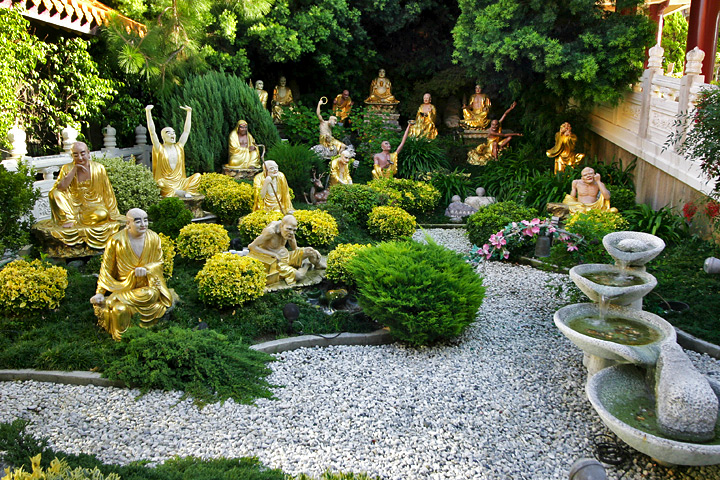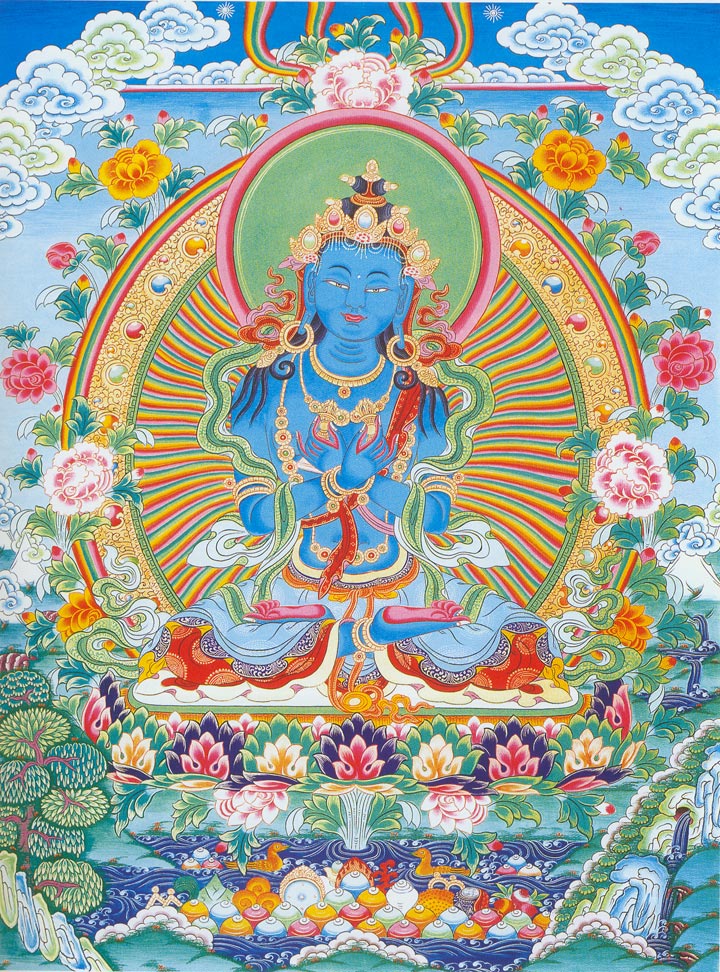|
Pure Abodes
The Śuddhāvāsa (Pāli: ; Tib: ) worlds, or "Pure Abodes", are distinct from the other worlds of the ' in that they do not house beings who have been born there through ordinary merit or meditative attainments, but only those Anāgāmins ("Non-returners") who are already on the path to Arhat-hood and who will attain enlightenment directly from the Śuddhāvāsa worlds without being reborn in a lower plane. Every Śuddhāvāsa deva is therefore a protector of Buddhism. ( Brahma Sahampati, who appealed to the newly enlightened Buddha to teach, was an Anagami from a previous Buddha). Because a Śuddhāvāsa deva will never be reborn outside the Śuddhāvāsa worlds, no Bodhisattva is ever born in these worlds, as a Bodhisattva must ultimately be reborn as a human being. Since these devas rise from lower planes only due to the teaching of a Buddha, they can remain empty for very long periods if no Buddha arises. However, unlike the lower worlds, the Śuddhāvāsa worlds are never ... [...More Info...] [...Related Items...] OR: [Wikipedia] [Google] [Baidu] |
Mahayana Buddhism
Mahāyāna ( ; , , ; ) is a term for a broad group of Buddhist traditions, texts, philosophies, and practices developed in ancient India ( onwards). It is considered one of the three main existing branches of Buddhism, the others being Theravāda and Vajrayāna.Harvey (2013), p. 189. Mahāyāna accepts the main scriptures and teachings of early Buddhism but also recognizes various doctrines and texts that are not accepted by Theravada Buddhism as original. These include the Mahāyāna sūtras and their emphasis on the ''bodhisattva'' path and ''Prajñāpāramitā''. Vajrayāna or Mantra traditions are a subset of Mahāyāna which makes use of numerous tantric methods Vajrayānists consider to help achieve Buddhahood. Mahāyāna also refers to the path of the bodhisattva striving to become a fully awakened Buddha for the benefit of all sentient beings, and is thus also called the "Bodhisattva Vehicle" (''Bodhisattvayāna''). Damien Keown (2003), A Dictionary of Buddhism', ... [...More Info...] [...Related Items...] OR: [Wikipedia] [Google] [Baidu] |
Anāgāmi
In Buddhism, an ''anāgāmin'' (Sanskrit; Pāli: ''anāgāmī'', lit. "non-returning") is a partially enlightened person who has cut off the first five fetters that bind the ordinary mind. ''Anāgāmins'' are the third of the four aspirants. The ''anāgāmin'' is not reborn into the human world after death, but into the heaven of the Pure Abodes, where only ''anāgāmins'' reside. There they attain full enlightenment (arahantship). Requisites for becoming an ''anāgāmin'' An ''anāgāmin'' is free from the lowest five chains or fetters (Sanskrit: ; Pali: ''pañcorambhāgiyāni-saṃyojanāni''; 五下分結) which are as follows: # Belief in ātma or ego/self (Sanskrit: ' or ''svakāya-dṛṣṭi''; Pāli: ''sakkāya-diṭṭhi''; 有身見) # Attachment to rites and rituals (Sanskrit: '' śīlavrata-parāmarśa-dṛṣṭi''; Pāli: ''sīlabbata-parāmāsa-diṭṭhi''; 戒禁取見) # Skeptical doubt (Sanskrit: '' vicikitsā''; Pali: ''vicikicchā''; 疑) # Sensuous cr ... [...More Info...] [...Related Items...] OR: [Wikipedia] [Google] [Baidu] |
Arhat
In Buddhism, an ''Arhat'' () or ''Arahant'' (, 𑀅𑀭𑀳𑀦𑁆𑀢𑁆) is one who has gained insight into the true nature of existence and has achieved ''Nirvana (Buddhism), Nirvana'' and has been liberated from the Rebirth (Buddhism), endless cycle of rebirth. The understanding of the concept has changed over the centuries, and varies between different schools of Buddhism and different regions. A range of views on the attainment of arhats existed in the early Buddhist schools. The Sarvastivada, Sarvāstivāda, Kāśyapīya, Mahāsāṃghika, Ekavyāvahārika, Lokottaravāda, Bahuśrutīya, Prajñaptivāda, and Caitika schools all regarded arhats as imperfect in their attainments compared to buddhahood, buddhas.Sree Padma. Barber, Anthony W. ''Buddhism in the Krishna River Valley of Andhra''. 2008. p. 44Warder, A.K. ''Indian Buddhism''. 2000. p. 277 Mahayana Buddhist teachings urge followers to take up the path of a bodhisattva, and to not fall back to the level of ... [...More Info...] [...Related Items...] OR: [Wikipedia] [Google] [Baidu] |
Brahma Sahampati
Brahma (, ) is a Hindu god, referred to as "the Creator" within the Trimurti, the trinity of supreme divinity that includes Vishnu and Shiva.Jan Gonda (1969)The Hindu Trinity, Anthropos, Bd 63/64, H 1/2, pp. 212–226.Jan Gonda (1969)The Hindu Trinity, Anthropos, Bd 63/64, H 1/2, pp. 218–219. He is associated with creation, knowledge, and the ''Vedas''. Brahma is prominently mentioned in creation legends. In some ''Puranas'', he created himself in a golden embryo known as the Hiranyagarbha. Brahma is frequently identified with the Vedic god Prajapati.;David Leeming (2005), The Oxford Companion to World Mythology, Oxford University Press, , page 54, Quote: "Especially in the Vedanta Hindu Philosophy, Brahman is the Absolute. In the Upanishads, Brahman becomes the eternal first cause, present everywhere and nowhere, always and never. Brahman can be incarnated in Brahma, in Vishnu, in Shiva. To put it another way, everything that is, owes its existence to Brahman. In this se ... [...More Info...] [...Related Items...] OR: [Wikipedia] [Google] [Baidu] |
Bodhisattva
In Buddhism, a bodhisattva is a person who has attained, or is striving towards, '' bodhi'' ('awakening', 'enlightenment') or Buddhahood. Often, the term specifically refers to a person who forgoes or delays personal nirvana or ''bodhi'' in order to compassionately help other individuals reach Buddhahood. In the Early Buddhist schools, as well as modern Theravāda Buddhism, bodhisattva (or bodhisatta) refers to someone who has made a resolution to become a Buddha and has also received a confirmation or prediction from a living Buddha that this will come to pass. In Theravāda Buddhism, the bodhisattva is mainly seen as an exceptional and rare individual. Only a few select individuals are ultimately able to become bodhisattvas, such as Maitreya. In Mahāyāna Buddhism, a bodhisattva refers to anyone who has generated '' bodhicitta'', a spontaneous wish and compassionate mind to attain Buddhahood for the benefit of all sentient beings. Mahayana bodhisattvas are spiritua ... [...More Info...] [...Related Items...] OR: [Wikipedia] [Google] [Baidu] |
Sarvāstivāda
The ''Sarvāstivāda'' (; ;) was one of the early Buddhist schools established around the reign of Ashoka (third century BCE).Westerhoff, The Golden Age of Indian Buddhist Philosophy in the First Millennium CE, 2018, p. 60. It was particularly known as an Abhidharma tradition, with a unique set of seven canonical Abhidharma texts.Westerhoff, 2018, p. 61. The Sarvāstivādins were one of the most influential Buddhist monastic groups, flourishing throughout North India, especially Kashmir and Central Asia, until the 7th century CE. The orthodox Kashmiri branch of the school composed the large and encyclopedic ''Abhidharma Mahāvibhāṣa Śāstra'' around the time of the reign of Kanishka (c. 127–150 CE). Because of this, orthodox Sarvāstivādins who upheld the doctrines in the ''Mahāvibhāṣa'' were called ''Vaibhāṣikas.'' There have been debates about the exact chronological emergence of Sarvastivadins from Sthavira nikāya. According to the Theravada, Theravādin ''D ... [...More Info...] [...Related Items...] OR: [Wikipedia] [Google] [Baidu] |
Theravada
''Theravāda'' (; 'School of the Elders'; ) is Buddhism's oldest existing school. The school's adherents, termed ''Theravādins'' (anglicized from Pali ''theravādī''), have preserved their version of the Buddha's teaching or ''Dharma (Buddhism), Dhamma'' in the Pāli Canon for over two millennia. The Pāli Canon is the most complete Buddhist canon surviving in a Indo-Aryan languages, classical Indian language, Pāli, which serves as the school's sacred language and ''lingua franca''.Crosby, Kate (2013), ''Theravada Buddhism: Continuity, Diversity, and Identity'', p. 2. In contrast to Mahāyāna and Vajrayāna, Theravāda tends to be conservative in matters of doctrine (''pariyatti'') and monastic discipline (''vinaya''). One element of this Religious conservatism, conservatism is the fact that Theravāda rejects the authenticity of the Mahayana sutras (which appeared onwards). Consequently, Theravāda generally does not recognize the existence of many Buddhas and bodhisattva ... [...More Info...] [...Related Items...] OR: [Wikipedia] [Google] [Baidu] |
Akaniṣṭha
In classical Buddhist Cosmology, ''Akaniṣṭha'' (Pali: ''Akaniṭṭha,'' meaning "Nothing Higher", "Unsurpassed") is the highest of the Pure Abodes, and thus the highest of all the form realms. It is the realm where devas like Maheśvara live. In Mahayana Buddhism, Akaniṣṭha is also a name for the Pure Land (Buddhafield) of the Buddha Vairocana. This is also the setting of the '' Ghanavyūha Sūtra.'' Tibetan Buddhism, Akaniṣṭha (Tib. '''og min)'' often describes three Akaniṣṭhas: # The Ultimate Akaniṣṭha, the formless state of dharmakaya, the dharmadhatu, i.e. the ultimate reality. # The Densely Arrayed Akaniṣṭha (Tib. '''Og min rgyan stug po bkod pa''; Skt. ''Ghanavyūhakaniṣṭha''), or the "Symbolic Akaniṣṭha" which is the realm of sambhogakaya. "Ghanavyūha Akaniṣṭha", refers to the pure Saṃbhogakāya Buddha field out of which emanate all Nirmāṇakāya Buddhas and Buddhafields such as Sukhāvati. It is the supreme Buddhafield in whic ... [...More Info...] [...Related Items...] OR: [Wikipedia] [Google] [Baidu] |
Śakra (Buddhism)
Indra, with the epitaph of Śakra ( ; ) is the ruler of the Trāyastriṃśa Heaven according to Buddhist cosmology. The name Śakra ("powerful") as an epithet of Indra is found in several verses of the Rigveda. Indra is also referred to by the title "Śakra, Lord of the Devas" (Sanskrit: ; Pali: ). In East Asian cultural traditions, Indra Śakra is known as () or () in Chinese, as () in Japanese, as () in Korean, and as () or () in Vietnamese. In Chinese Buddhism, Indra Śakra is sometimes identified with the Taoist Jade Emperor ( , often simplified to ); both share a birthday on the ninth day of the first lunar month of the Chinese calendar (usually in February). The Trāyastriṃśa heaven in which Indra Śakra rules is located on the top of Mount Meru, imagined to be the polar center of the physical world, around which the Sun and Moon revolve. Trāyastriṃśa is the highest of the heavens in direct contact with humankind. Like all deities, Indra Śakra is long-l ... [...More Info...] [...Related Items...] OR: [Wikipedia] [Google] [Baidu] |
Maheśvara (Buddhism)
Maheśvara (Sanskrit: महेश्वर; Pali: ''Mahissara''; traditional Chinese/Japanese: 大自在天; Pinyin: ''Dàzìzàitiān'', Rōmaji: ''Daijizaiten'') is a deva in Buddhist mythology. He is also sometimes referred to as Sabbalokādhipatī Devā in Pali literature. His main duty is to give spiritual knowledge. Maheśvara is sometimes revered as a bodhisattva. This deity is closely associated with the god Shiva in Hinduism. Etymology The Sanskrit name Maheśvara is composed of two "Mahā" and "Īśvara". The "ā" of mahā and the "ī" of īśvara combine to form a sandhi, which becomes "e", forming the word "Maheśvara". Mahā means "Great" and Īśvara means "lord", hence the name Maheśvara means "the great lord". Contemporary Maheśvara Present Maheśvara is Buddhist by religion, and was reborn as a Deva, because of his merit of donating a cup of honey to Kassapa Buddha in one of his previous lives. According to Karandavyuha Sutra, Maheśvara was born fro ... [...More Info...] [...Related Items...] OR: [Wikipedia] [Google] [Baidu] |
Buddhist Philosophical Concepts
Buddhism, also known as Buddhadharma and Dharmavinaya, is an Indian religion and philosophical tradition based on teachings attributed to the Buddha, a wandering teacher who lived in the 6th or 5th century BCE. It is the world's fourth-largest religion, with about 500 million followers, known as Buddhists, who comprise four percent of the global population. It arose in the eastern Gangetic plain as a movement in the 5th century BCE, and gradually spread throughout much of Asia. Buddhism has subsequently played a major role in Asian culture and spirituality, eventually spreading to the West in the 20th century. According to tradition, the Buddha instructed his followers in a path of development which leads to awakening and full liberation from '' dukkha'' (). He regarded this path as a Middle Way between extremes such as asceticism or sensual indulgence. Teaching that ''dukkha'' arises alongside attachment or clinging, the Buddha advised meditation practices and ... [...More Info...] [...Related Items...] OR: [Wikipedia] [Google] [Baidu] |









